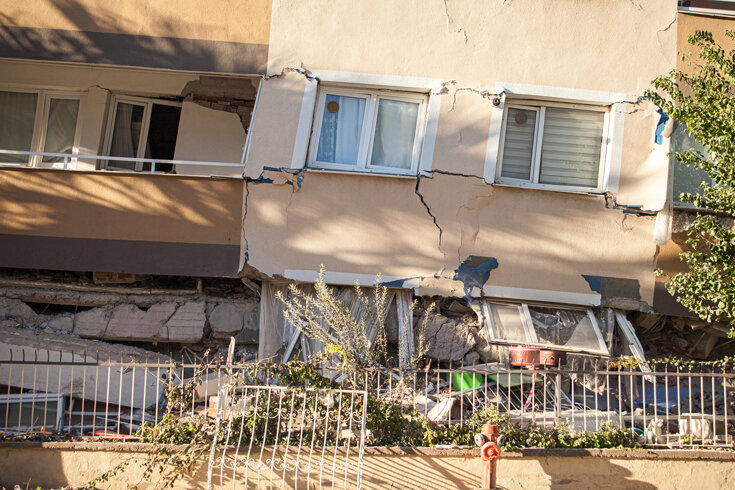Millions of us pay little or no attention to natural hazards. Of those who do, most worry more about hurricanes, tornadoes, floods, fires, and climate change than earthquakes.
Yet the clock keeps ticking down to the next big earthquake. If the clock ticks slowly, we will have time to better our geological understanding of some of the areas at risk. Perhaps more of our cities and towns will have adopted stricter building codes, and a few might have adopted mandatory retrofit laws. No doubt they’ll be made considerably stronger after the next really big North American earthquake. But what will it take to make them stronger before? This is the key question in cities that will experience damaging earthquakes in the future but haven’t had any in living memory.
“One of the reasons for not doing something is not having experienced it,” explains Robert Gifford, an environmental psychologist at the University of Victoria. “It’s what we call the crisis-response mentality. You don’t put up the sign that there’s a dangerous curve on the highway until somebody’s already gone off the road, or you don’t do earthquake preparation until one has already happened.”
Many people who have survived major earthquakes notice the lack of concern among those who have not. Honn Kao, who now works for the Geological Survey of Canada, returned home to Taiwan, in 1999, two days after a massive magnitude-7.7 earthquake had ravaged the island. The quake killed 2,000 and left another 100,000 homeless. Taiwan’s power stations also were heavily damaged, and its nuclear reactors shut down automatically. For many, that led to the loss of water and electricity. Honn and his family had to walk down nine flights of stairs to collect two pails of water—and carry them back up—at least three times each day. “The impact goes far beyond just the number of fatalities and injuries. It’s all the lives of millions of people who all of a sudden have a change that they do not expect,” he says. “These are the kinds of things that you will not be able to imagine unless you actually live through it.”
That may explain why some of the best-prepared people have direct experience with disasters. Both Anne Mullens and Claire Kelly lived through big earthquakes in Japan before returning to Canada, though the earthquakes were more than forty years apart. Mullens was ten years old and staying with her family in Tokyo when the city shook in 1968. She remembers hearing a grinding noise like she’d never heard before, followed by a sudden, violent shaking. A goldfish bowl on top of the television jumped into the air “in a cartoon-like fashion” and smashed on the floor.
Today, at her home in Victoria, Mullens has stockpiled a long list of essentials that includes emergency medical supplies, a propane stove, a tent, money, nonperishable food, and a wrench to turn off the neighbour’s gas line. She even has a few chickens that produce three eggs a day. Kelly is just as passionate about being prepared. She lived through the 2011 Tohoku earthquake: “I felt like I was on an amusement ride that I couldn’t get off.” When she came home, she gave everyone in her family an emergency kit for Christmas. Kelly now lives in New Brunswick, but she hasn’t forgotten what she learned in Japan. “To this day, I make sure my gas tank is full and my phone is fully charged,” she says.
In 1985, reporter Deborah Wilson endured the giant earthquake in Mexico City. She’d just taken a job in the city and was staying in a friend’s fourth-floor apartment when she awoke to the violent shaking of the magnitude-8 quake. It felt, she remembers, “like being in a boat on a sea of concrete.” After the shaking, she saw a nearby building collapse and spent days reporting on the tragic destruction of the city. Her experience in Mexico compelled her to research and report the risk to Vancouver and Victoria. “In our lifetime or our children’s or our grandchildren’s lifetime, there will be a similar earthquake here,” she says.
First-hand experience isn’t the only factor that determines who prepares and to what extent. Helene Joffe, a professor of psychology at University College London, and a team of researchers at the university’s EPICentre for Natural Hazards Resilience have studied attitudes toward earthquake preparation in several countries. They’ve found that most people living in seismic zones—Seattle, say, or Osaka—generally do little or nothing to prepare for an earthquake despite the significant risk of a major event. Joffe attributes that to paralyzing anxiety, fatalism, and a distrust of local authorities. Of course, others will avoid making preparations because they have faith that a higher power will protect them. Either way, the end result is the same: they do not take measures to stay alive during and after an earthquake.
Gifford, from the University of Victoria, calls the reasons many of us do nothing the Dragons of Inaction. They include social pressure not to complain or do anything, a feeling that preparing is too difficult or too expensive, confidence that a few supplies set aside in the basement will be enough, and what psychologists call temporal dislocation, which allows someone to shrug off the threat of disaster as something unlikely to happen in their lifetime. How can emergency planners slay the Dragons of Inaction? Gifford thinks the key is to convince people and communities that their actions can make a difference. “I think it comes down to raising awareness of the possibility but pairing it with the sense that you are able to do something about it.”
On the West Coast, talk about mandating seismic retrofits is abundant, but moving from talk to action can be exceedingly difficult. That has certainly been the case in Portland, where city commissioners tried in 2018 to tackle 1,600 vulnerable brick buildings. They debated a new mandate that would require the building owners to perform retrofits within ten or fifteen years. Some viewed this as a simple and sensible solution, but many owners complained. It is especially expensive to fortify these buildings properly. Many old brick beauties have received half-measures, like removing the parapets and cornices or fastening them to the roof. That should prevent a cascade of bricks from raining down during a moderate earthquake. But those buildings also need the more expensive work of bolting floors to walls, and without it, they remain extremely vulnerable to collapse in a major earthquake.
Building owners argued for more time and only the minimum level of seismic retrofit. Some urged commissioners to abandon the idea completely, arguing that a combination of market forces and natural forces would take care of the situation—eventually. “When or if the earthquake happens,” the Hawthorne Boulevard Business Association argued, “then the properties can be sold and new buildings will rise out of the rubble.” The business association said nothing about the many dead bodies that would likely have to be pulled out of the rubble first.
In many big cities with high housing costs and growing homeless populations, an obvious safety measure quickly turns into a social justice dilemma for local politicians. Expensive repairs could affect many low-income renters, who might face significant rent increases or even lose their homes to demolition if their landlords can’t afford the repair bills. But Eric Holdeman, a veteran emergency planner in Seattle, bristles at the suggestion that poor people will be hurt by mandatory retrofits. “If you look at who disaster impacts, it always impacts the poor, low-income people more because they’re in substandard housing,” he notes. “We’re just setting them up to be the victims again.” The people who have opposed mandatory seismic retrofit measures in both Portland and Seattle have put historical preservation and affordable housing on the same level as life safety, he argues. “They’re all being treated as equal, and life safety is not equal to me. I think you’ve got to put a line in the sand and get it done.”
Cities like Los Angeles have started setting mandatory requirements for seismic assessments and retrofits, and even Vancouver, which has done comparatively little to compel property owners to make buildings safe, has recently started taking a closer look at its towers. Many people assume that governments have always been proactive about the safety of public structures. But the truth is that many municipal, state or provincial, and federal governments are delaying these crucial, life-saving steps, and some aren’t even considering them. In other words, many of our governments are complacent. It could even be argued that our building codes are complacent too.
“One of the really big issues,” civil engineer Perry Adebar says, “is that people think the building code is something that ensures buildings do really well. And it’s not. It’s a useful document, and engineers have to follow it, but it’s full of holes.” One of the biggest problems with most building codes, he argues, is that no one is certain of their ultimate purpose. “Are we just trying to make sure people don’t die in the earthquake, or do we want buildings to be usable? And that’s a big debate that’s going on worldwide.”
The design of any new building includes a lot of things that have nothing to do with safety. The City of Vancouver made aesthetics mandatory, declaring that “higher buildings must establish a significant and recognizable new benchmark for architectural creativity and excellence.” But Adebar says the city failed to make seismic resilience an explicit requirement for many years “because of a mistaken belief that the Canadian building code ensures that buildings will perform adequately during an earthquake.” The fact that the building code requires buildings to remain standing during an earthquake but not necessarily usable afterward puts the postquake future of many modern buildings in doubt.
But policies can change, and so can people. When Doug Dougherty, a long-time school superintendent in Seaside, Oregon, campaigned to close vulnerable schools, he encountered resistance. Some people would simply avoid the topic with him, others didn’t believe something so awful could happen in the place they’d lived their whole lives, and still others recognized the danger but didn’t want to talk about it. “The comment I heard over and over again was, ‘It just makes us look stupid for living here.’ And they don’t want to be reminded of that.” But Dougherty kept reminding the people of Seaside that, one day, one of nature’s most terrifying forces would wash over their homes.
Slowly, year by year, he convinced more and more of his fellow citizens that they could do something about it. When Seaside residents first voted on whether to pay for a new school campus, the proposition failed. But Dougherty learned something from the process. He focused on smaller, more achievable precautions. He introduced the first tsunami evacuation drills and convinced his staff to learn ham radio so they could communicate with emergency officials if all other means of communication failed. Little by little, one person at a time, Dougherty and other like-minded individuals convinced the community to prepare.
A sense of community can be crucial, and developing emergency plans with neighbours can save lives. But, Gifford cautions, a strong attachment to place is problematic if it prevents people from leaving places where they really shouldn’t stay. Of course, not everyone can move. Millions of impoverished people in the low-lying flood plains of Bangladesh, for instance, have little choice but to stay put. In the developed world, however, people who live on flood plains and tsunami inundation zones face mounting pressure to move, as do people living where wildfires or rising sea levels threaten their homes.
In 2014, a passionate debate followed Oregon State University’s announcement of a new marine-studies building in Newport, right in the tsunami inundation zone, where the university’s Hatfield Marine Science Center had been built, more than fifty years earlier, on a narrow spit of land across the bay from the city. The backlash to the decision was loud and clear. Vicki McConnell, the state geologist at the time, urged the university president to reconsider. Geological records show tsunami waves as high as thirteen metres crashing ashore in the area in the past, she pointed out, and the Hatfield Center is no higher than six metres above sea level. “I know you are not willing to put even one, much less 500, students and researchers in peril every day,” she wrote. At least a dozen faculty members echoed her concerns, warning that the new facility could “threaten lives, damage buildings and hobble the research capacity of this flagship institute.”
University officials insisted that the location was the best site for the new facility because of the need to pump nearly a million gallons of seawater from the bay into laboratories every day. Pumping that water uphill would be prohibitively expensive, they argued. The new building would be built to the highest seismic standards and able to sustain a magnitude-9 earthquake. The building would be attached to a series of steel-reinforced concrete pilings sunk deep into the sandy soil. That sandy land is likely to liquefy in a giant subduction earthquake, but the pilings are designed to remain standing and support the roof, which would act as a vertical tsunami evacuation tower.
Depending whom you ask, Oregon State University should be either applauded for including the most stringent safety measures available in its new building or condemned for putting that building in the path of a future tsunami. Only when the tsunami strikes will anyone know if the university made a wise decision.
The truth is that none of us can be sure how our homes and cities will respond—or how we will. We couldn’t prepare for every possible outcome even if we wanted to. But, Gifford says, “This is not an event you can do nothing about. You can’t stop the earthquake from happening. You can stop the earthquake from killing you.”
Adapted from On Borrowed Time: North America’s Next Big Quake © 2021 by Gregor Craigie. Reprinted by permission of Goose Lane Editions.





